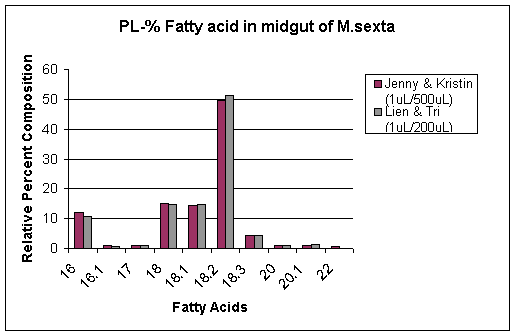 |
|||||||||||||||
|
Lipid Analysis of Manduca Sexta Midgut |
||||||||||||||
|
Conclusion |
|||||||||||||||
|
Our research hypothesis is: Does the midgut of Manduca sexta contain enough arachidonic acid (C20:4) for prostaglandin biosynthesis? The purpose of this lab was to find out whether arachidonic acid is present in the midgut of Manduca sexta larvae. We know that the midgut of a Manduca sexta is capable of synthesizing prostaglandins (Büyükgüzel, 2002) and that arachidonic acid is a required substrate for synthesizing prostaglandin. After we completed the lipid extraction and fatty acids analysis from the midgut of a Manduca sexta, we found that there was no evidence for the presence of arachidonic acid. We concluded that the midgut does not contain a adequate level of arachidonic acids for protaglandans biosynthesis. (See Figure 1) |
|||||||||||||||
|
|
|||||||||||||||
|
Figure 1. Fatty acid composition of Manduca sexta midgut phospholipids. Fatty acids are denoted by the number of carbons and double bonds. Ex. Linoleic acid (C18:2) contains 18 carbons and two double bonds) |
|||||||||||||||
|
The conclusion leads us to another question. How does the midgut obtain the necessary arachidonic acid for prostaglandin biosynthesis? There are two possible explanations for this question. 1. Arachidonic acid is tranported into the midgut by a some transport molecule from an exogenous source. If so, what is the transport molecule and from where is it transported? 2. Arachidonic acid is metabolized from some other polyunsaturated fatty acid (e.g. linoleic acid. C18:2). This metabolism would require additional elongation and desaturation activity.
|
|||||||||||||||
